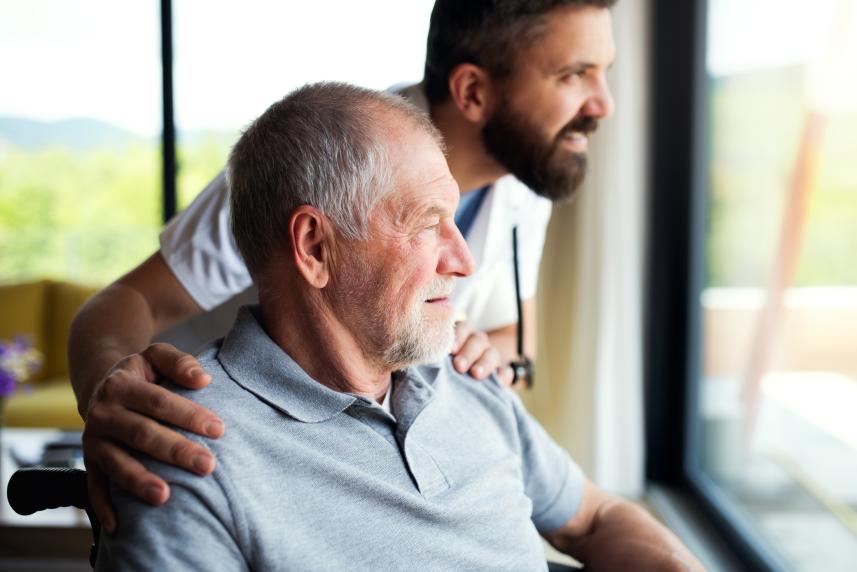Coming home after nursing rehab: Your seven-step recovery plan
Here’s how you and your loved ones can set the stage for optimal recovery

Returning home after a stay in a nursing rehabilitation center, for the most part, feels like a positive experience. But it’s also a time filled with new questions and concerns about living on your own again, staying safe, and continuing your recovery. These expert-endorsed and research-tested strategies can help you and your loved ones better manage your day-to-day health needs and stay on the fast track to healing.
1. Understand your discharge plan
Before you leave a nursing rehab center, a team creates a discharge plan that usually includes you, a loved one involved with your care, your doctor, a nurse, a social worker, and a physical or occupational therapist. It should include the following information:
- Why you needed rehab
- A list of medications you should take at home, and how and when to take them
- What to do if your condition changes or you have warning signs of a health problem
- A schedule of follow-up appointments with your doctor
- How to get test results
- The name and phone number of a contact person in case you have questions
- Any in-home or outpatient therapies your doctor recommends, including exercise plans
This plan is a blueprint for your successful recovery at home. Don’t hesitate to call the contact person if you have questions. The better you and your loved one understand what to do and what to expect, the better your recovery will go.
2. Set up your home for a safe and successful recovery
Before leaving a nursing rehab, you and your loved ones will need to ask your care team for a specific, detailed list of the special equipment you’ll need during your at-home recovery process. This might include:
- A walker or cane
- Grab bars
- A special chair or bed cushions
- A shower chair, commode, or toilet frame with arms
- Special bandages or skincare items
- Disposable gloves
Make sure that you or a loved one find out who will supply these items (the rehab facility or home health care agency may provide them, or you may have to purchase them yourself). Independence Blue Cross (Independence) Medicare Advantage members can shop for these products using their over-the-counter (OTC) allowance (a $30 quarterly allowance, up to $120 per year). This allowance can be used to pay for products from the Independence OTC catalog, offered through Convey.* You can access the catalog by visiting ibxmedicare.com/otc. See the “Bathroom Safety & Fall Prevention” section for available products.
The rehab facility staff might also need to fit certain items properly or teach you and your helpers how to use them safely and effectively.
3. Arrange for help with personal care and everyday needs
Once you’re back home after your stay in the rehab facility, you may need help for a while with bathing, dressing, doing certain household chores, getting to the bathroom, picking up prescriptions, and going to medical appointments. Your discharge plan should include information about who will assist you; it may be a relative, friend, neighbor, other assistant, or home care. This could also include someone who is hired to help you. Always check references and do a background check before hiring someone, as recommended by the Family Caregiver Alliance.
4. Plan healthy meals, too
Food plays an essential part of any recovery, so aim for ample servings of produce, fish, lean meats, eggs, and beans to help repair body tissues and fight infection.
Here’s what you should aim to consume each day, according to the U.S. Department of Agriculture:
- 2½ to 3 cups of veggies
- 1½ cups of fruit (a medium orange or small apple count as 1 cup)
- 5 to 6 ounces of protein (a medium-sized chicken breast is about 3 ounces)
- 5 to 8 ounces of grains (1 slice of bread, a cup of ready-to-eat cereal or a half-cup of rice count as one ounce; try to make at least half of servings whole grains)
- 3 cups of dairy (a cup of milk or yogurt or two slices of cheese count)
- 5 to 7 teaspoons of fats (oil, salad dressing)
If you cannot shop or prepare meals for yourself right now, ask a relative, friend, or neighbor for help. Programs in your community, such as Meals on Wheels and MANNA, can also provide nutritious food options.
5. Understand your medications
Make sure you have a list of all the medications you should be taking as you recover at home, including new prescriptions and medications you were taking before your stay in the rehab center. Ask your doctor or pharmacist how to take them (the dose, what times of day to take them, and whether to take them with or without food). Ask if you should take any of your new prescription drugs instead of an old medication. Call your primary care doctor to ask him or her to review all of the medications and supplements you’re taking, and to answer any questions you may have.
6. Mark upcoming medical appointments on your calendar
After you return to your home, you will likely have follow-up appointments with your primary care doctor, surgeon, or another specialist. Before you leave the rehab center, find out which appointments you will need and whether the center can make the appointments for you. Ask how your primary care doctor can receive records of your care before your next visit.
7. Stay safe
It’s important to recognize early warning signs of problems and know what to do (such as calling your doctor or calling 911). These “red flags” will differ depending on your health condition. If you experience a fever, severe pain, shortness of breath, or any other concerning symptoms, call your doctor right away for help or 911 in case of an emergency. Also, understand what you should not do on your own for a while, such as walking unassisted or lifting heavy objects.
*The Independence Blue Cross Over the Counter benefit is underwritten by Keystone Health Plan East/QCC Insurance Company and is administered by Convey Health Solutions, Inc., an independent company.


